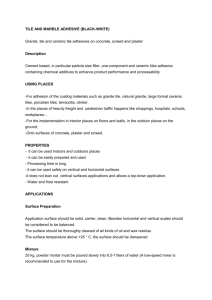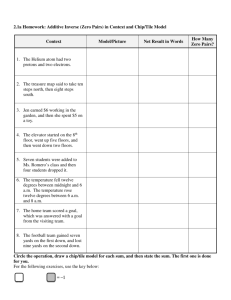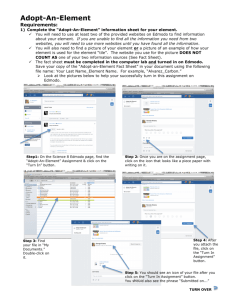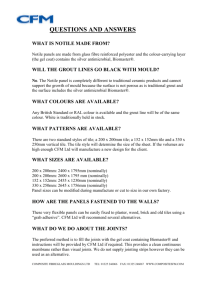Installation of Large Format Tile & Stone
advertisement
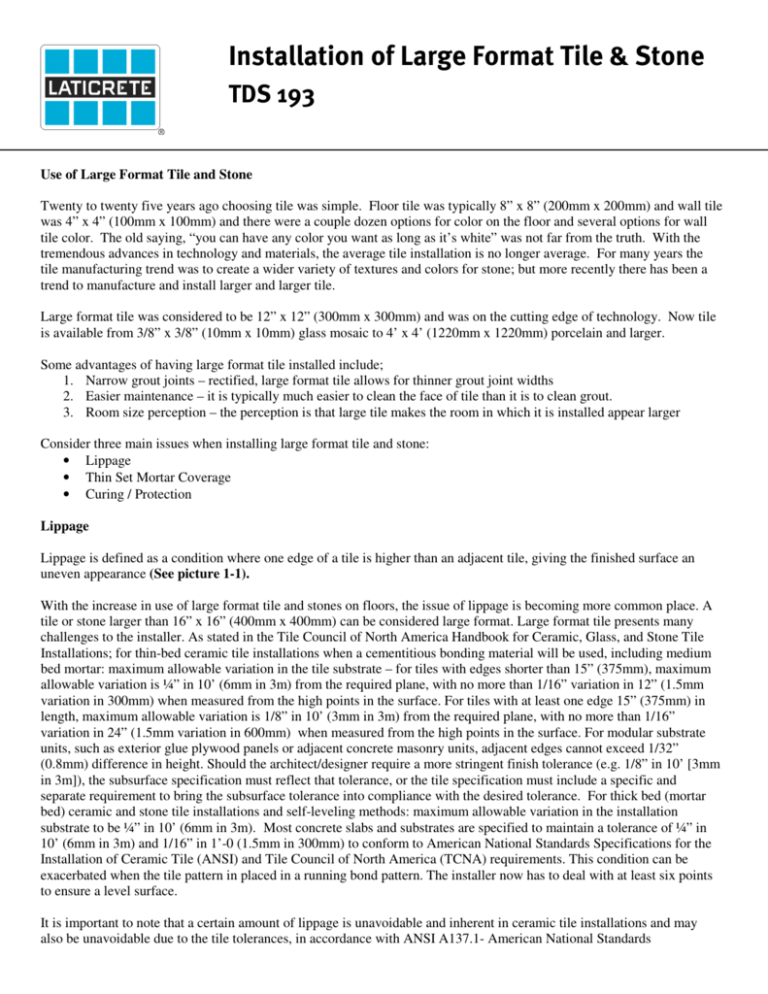
Installation of Large Format Tile & Stone TDS 193 Use of Large Format Tile and Stone Twenty to twenty five years ago choosing tile was simple. Floor tile was typically 8” x 8” (200mm x 200mm) and wall tile was 4” x 4” (100mm x 100mm) and there were a couple dozen options for color on the floor and several options for wall tile color. The old saying, “you can have any color you want as long as it’s white” was not far from the truth. With the tremendous advances in technology and materials, the average tile installation is no longer average. For many years the tile manufacturing trend was to create a wider variety of textures and colors for stone; but more recently there has been a trend to manufacture and install larger and larger tile. Large format tile was considered to be 12” x 12” (300mm x 300mm) and was on the cutting edge of technology. Now tile is available from 3/8” x 3/8” (10mm x 10mm) glass mosaic to 4’ x 4’ (1220mm x 1220mm) porcelain and larger. Some advantages of having large format tile installed include; 1. Narrow grout joints – rectified, large format tile allows for thinner grout joint widths 2. Easier maintenance – it is typically much easier to clean the face of tile than it is to clean grout. 3. Room size perception – the perception is that large tile makes the room in which it is installed appear larger Consider three main issues when installing large format tile and stone: • Lippage • Thin Set Mortar Coverage • Curing / Protection Lippage Lippage is defined as a condition where one edge of a tile is higher than an adjacent tile, giving the finished surface an uneven appearance (See picture 1-1). With the increase in use of large format tile and stones on floors, the issue of lippage is becoming more common place. A tile or stone larger than 16” x 16” (400mm x 400mm) can be considered large format. Large format tile presents many challenges to the installer. As stated in the Tile Council of North America Handbook for Ceramic, Glass, and Stone Tile Installations; for thin-bed ceramic tile installations when a cementitious bonding material will be used, including medium bed mortar: maximum allowable variation in the tile substrate – for tiles with edges shorter than 15” (375mm), maximum allowable variation is ¼” in 10’ (6mm in 3m) from the required plane, with no more than 1/16” variation in 12” (1.5mm variation in 300mm) when measured from the high points in the surface. For tiles with at least one edge 15” (375mm) in length, maximum allowable variation is 1/8” in 10’ (3mm in 3m) from the required plane, with no more than 1/16” variation in 24” (1.5mm variation in 600mm) when measured from the high points in the surface. For modular substrate units, such as exterior glue plywood panels or adjacent concrete masonry units, adjacent edges cannot exceed 1/32” (0.8mm) difference in height. Should the architect/designer require a more stringent finish tolerance (e.g. 1/8” in 10’ [3mm in 3m]), the subsurface specification must reflect that tolerance, or the tile specification must include a specific and separate requirement to bring the subsurface tolerance into compliance with the desired tolerance. For thick bed (mortar bed) ceramic and stone tile installations and self-leveling methods: maximum allowable variation in the installation substrate to be ¼” in 10’ (6mm in 3m). Most concrete slabs and substrates are specified to maintain a tolerance of ¼” in 10’ (6mm in 3m) and 1/16” in 1’-0 (1.5mm in 300mm) to conform to American National Standards Specifications for the Installation of Ceramic Tile (ANSI) and Tile Council of North America (TCNA) requirements. This condition can be exacerbated when the tile pattern in placed in a running bond pattern. The installer now has to deal with at least six points to ensure a level surface. It is important to note that a certain amount of lippage is unavoidable and inherent in ceramic tile installations and may also be unavoidable due to the tile tolerances, in accordance with ANSI A137.1- American National Standards Specifications for Ceramic Tile. The TCNA (page 34) and ANSI (page 26 – section A108.02 4.3.7) manuals provide information on what the appropriate tolerance levels should be. This discussion deals with the issue of excessive lippage. Picture 1-1 – Large format tile highlight imperfections in the substrate. Since the tile and stone facial dimension is much larger, the facial dimension tolerance will also increase. This can present problems when attempting to maintain tight joints. The joint width can be only as tight as the actual facial dimension range of the tile. In many cases, even rectified tiles (tiles that are calibrated to a tighter tolerance) will require a grout joint to be at least 3/16” (4.5mm) in width depending on the size. Non-rectified tiles may necessitate a wider minimum grout joint width. The ceramic tile industry is currently discussing ways in which to address this important issue. ANSI A137.1 – American National Standard Specifications for Ceramic Tile is being revised to reflect the advancement in tile sizes and technology. In addition, some new language is being batted around and may be included in the next revision of the ANSI Manual Specifications for the Installation of Ceramic Tile. The change may read something to the effect of; ‘To accommodate the range in facial dimensions of the tile supplied for a specific project, the actual grout joint size may, of necessity, vary from the grout joint size specified. The actual grout joint size shall be at least 3 times the actual range of facial dimensions of the tile supplied. Example: for tile having a total variation of 1/16” in facial dimensions, a minimum 3/16” (4.5mm) grout joint shall be used. Nominal centerline of all joints shall be straight and of even width, with due allowances for hand molded or rustic tiles. In no circumstance shall the grout joint be less than 1/16” (1.5mm).’ For more information on lippage and grout joint width, please refer to TDS 164 “Lippage – Causes and Prevention”. Adhesive Mortar Coverage Complete bedding of the tile with the appropriate adhesive mortar is another area that requires attention. Lack of thin set mortar coverage can lead to cracked tile and grout and loss of bond to the tiles. Use the appropriate sized notch trowels (see picture 1.2) for troweling technique) and tap or twist the tiles in place to properly bed the tiles. Large format tiles can be back buttered with additional thin set mortar to ensure that the appropriate coverage is achieved. Notice the lack of coverage in picture 1.3. To correct these errors, carefully remove the grout around the perimeter of the loose tiles and any hardened thin set mortar so as to not disturb any tiles that are still well bonded and then replace using the appropriate troweling technique. Picture 1.2 - ¾” (18mm) loop notch trowel with a medium bed mortar used for large format tiles or stones. Trowel thin set mortar in one direction holding trowel at a 45 degree angle. Notice the full ribbons of mortar that left behind. Picture 1.3 - Insufficient thin set mortar coverage. Removal of a tile reveals many voids that are present in the hardened thin set mortar. Trowel ribbons are inconsistent which will also lead to poor coverage and mortar transfer to the backs of the tiles. Size of the tile will also determine exactly what tools are required to properly bed the tile. The simple logic is that the larger the tile, the larger the notch trowel size must be. A ¼” x ¼” (6mm x 6mm) square notch trowel might be fine for a 4 1/4” x 4 1/4” (108mm x 108mm) tile; it will not be suitable for installation of 20” x 20” (500mm x 500mm) tile. It is important that this be understood, and that the installer pulls tiles up after they are installed to make sure that the desired Picture 1.4 – Ceramic tile removed during the installation to verify proper coverage is being attained. Notice the lower right hand corner of the tile is lacking coverage. This will undoubtedly lead to a cracked tile. coverage is achieved and that the surface of the tile installation is flat and true. Industry standards require that a minimum coverage of 80% be attained for interior, non-wet areas, and a minimum coverage of 95% be attained for any interior, wetarea or any exterior installation. There have been significant advances made in trowel technology over the past few years that help make the installer’s job easier. General guidelines for trowel/tile size are; 3/16 x 5/32 (5mm x 4mm) v-notch 1/4” x 1/4” (6mm x 6mm) square notch 1/4” x 3/8” (6mm x 9mm) square notch 1/2” x 1/2” (12mm x 12mm) square or round notch 3/4" x 3/4” (18mm x 18mm) round notch Mosaics to 4 ¼” x 4 ¼” (108mm x 108mm) wall tile 4” to 6” (100mm to 150mm) floor or wall tile 6” to 12” (150mm to 300mm) floor or wall tile 13” to 20” (330mm to 500mm) floor or wall tile 20” (500mm x 500mm) or larger floor or wall tile No back-buttering (required) No back-buttering (required) Back-butter 8” x 8”(200mm x 200mm) tile or larger† Back-butter† Back-butter† **The chart above is intended as a guideline only and results should be checked during installation to make sure that proper coverage is achieved. † Use of a full contact mortar (e.g. SURE SET™) will eliminate the need for back-buttering. Consult LATICRETE product data sheets for specific installation instructions. Choosing the best adhesive for the job is also important to assure a long-lasting installation. Some options are 254 Platinum, SURE SET (as a full contact thin-set mortar), 255 MULTIMAX™ (for non-sag installations on walls or as large, heavy tile mortar on floors), LHT™ (for thin or large, heavy installations on floors), 4-XLT (for non-sag installations on walls or as large, heavy tile mortar on floors), 4-XLT Rapid (for rapid setting, non-sag installations on walls or as large, heavy tile mortar on floors), or 220 Marble and Granite Mortar gauged with 333 Flexible Additive as a large, heavy tile mortar up to ¾” (19mm) thick. For installations that require sound control and /or crack isolation, use 125 Sound and Crack Adhesive. The practice of back-buttering is recommended for any tile that is larger than 8” x 8” (200mm x 200mm) to help achieve maximum coverage/bedding†. Once the tile has set firm, grout with SPECTRALOCK® PRO Premium Grout*; SPECTRALOCK PRO Grout; PERMACOLOR® Select^; PERMACOLOR Grout, 1500 Sanded Grout mixed with 1776 Grout Enhancer; or, 1600 Unsanded Grout mixed with 1776 Grout Enhancer. It is also important that proper allowance be made for movement in large format installations, just like ALL tile installations. Allowance for movement should be made around the perimeter of the room and any hard abutments within the tiled area. For more information on movement joints please refer to Tile Council of North America (TCNA) Handbook for Ceramic, Glass, and Stone Tile Installation EJ171. Curing / Protection Another issue that must be dealt with when using large format tiles and stones in commercial applications is the issue of curing and protection. Larger tile and stones will require a longer cure time due to the fact that the mortar simply cannot cure quickly, especially under a dense porcelain bodied tile. Most adhesive manufacturer’s will have varying suggestions on when an installation can be opened to other trades and traffic (including traffic from other trades, hand trucks, carts, scissor lifts, and other heavy machinery or vehicles). While there is no empirical data / formula that specifically address the cure rate in relation to the facial dimensions of tile, some manufacturers have had good experience in maintaining a minimum 7 day cure at 70°F (21°C). Once the areas are opened to vehicular traffic, protect the newly tiled floors. It is important to note that even rapid setting latex fortified portland cement thin set mortars must be allowed to cure for a minimum of 7 days at 70°F (21°C). Although rapid setting mortars allow grouting and light foot traffic on newly tiled floors, heavy traffic and work can still damage the installation. In addition, allow a longer cure period when temperatures are below 70°F (21°C), when humidity levels exceed 60% R.H. or when large format porcelain bodied tiles are utilized. The ceramic tile industry currently provides the following language in this regard: “After completion and cleaning, the obligation of the tile contractor ceases as to damage or injury which may be done to the tilework by others.” – ANSI A108.01 – Section 3.8 “To avoid damage to finished tilework, schedule floor installations to begin only after all structural work, building enclosure, and overhead finishing work, such as ceilings, painting, mechanical and electrical work, are completed. Keep all traffic off finished tile floor floors until they have fully cured. Builder shall provide up to ¾” thick plywood or OSB protection over non-staining Kraft® paper to protect floors after installation materials have cured [up to 28 days following the tile installation]. Covering the floor with polyethylene or plywood in direct contact with the floor may adversely affect the curing process of grout and latex/polymer modified portland cement mortar.” – 2015 TCNA Handbook “Protecting New Tile Work” – page 37. LATICRETE International, Inc. strongly recommends the use of installers who have demonstrated their commitment to their craft and taken the time to stay current with the latest materials and methods. Requiring references and a portfolio along with a bid or estimate is a good way to ensure the installer has successfully completed work of similar size, scope, and complexity. * United States Patent No.: 6,881,768 (and Other Patents) ^ United States Patent No.: 6,784,229 (and Other Patents) References: TCNA Handbook for Ceramic Tile Installation. Tile Council of North America, Inc. Anderson, SC, 2014. American National Standard Specifications for Installation of Ceramic Tile. Tile Council of North America, Inc. Anderson, SC, 2015. Technical Data Sheets are subject to change without notice. For latest revision, check our website at www.laticrete.com TDS 193.doc R 9 October 2015
